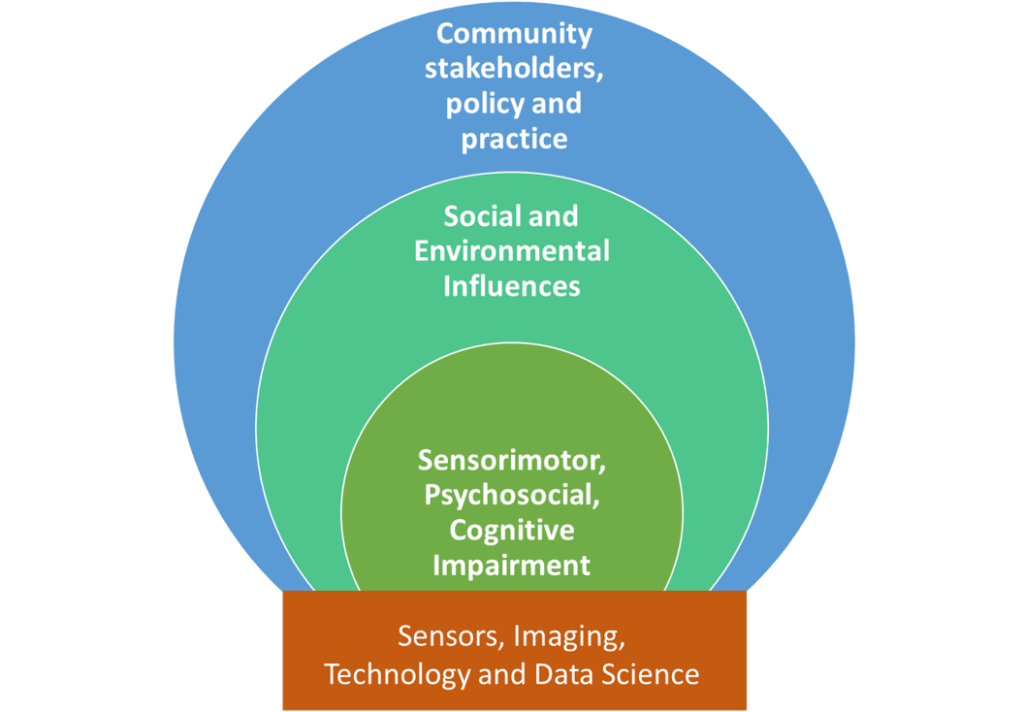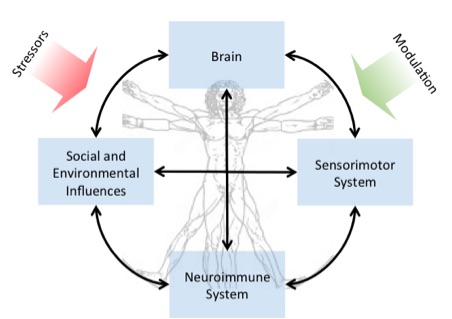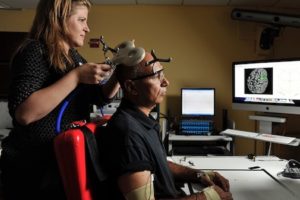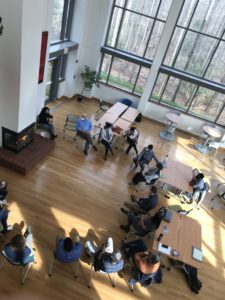Research Focus
The theoretical foundation of CASBBI is based on the science of complex adaptive systems applied to a biopsychosocial model of disability. We envision that health and function in individuals with physical and mental disabilities is determined by the interactions between four adaptive systems (brain, sensorimotor, neuroimmune, and psychosocial influence mechanisms). External stressors and the corresponding adaptations of these systems lead to the allostatic load that contributes to illness and diminished quality of life. External modulations can reduce allostatic load and improve wellness.

Expertise
Recognizing that chronic disability is characterized by dysfunction in multiple interrelated systems across physical biological and psychosocial domains, CASBBI brings together experts in neuroscience, physics, engineering, computer science, psychology, and rehabilitation to pursue convergence research that integrates knowledge across disciplines. We aim to uncover underlying neurobiological mechanisms of disability, modulate them through novel technological approaches, and develop measurement tools sensitive to changes resulting from the interventions.
The core methodological expertise of CASBBI is in multiscale neuromodulation and neuroimaging, human-machine interactions, and sensorimotor integration, and human movement. The core facilities include shared research instrumentation, core imaging facilities, and shared wet and dry lab facilities on the Fairfax campus of George Mason University.

Human-Machine Interaction
Assistive technologies, ranging from sophisticated bionic devices for individuals with physical disability to therapeutic social robots for individuals with psychosocial disability, have tremendous promise in improving quality of life and function. However, the challenge continues to be the interface between human users and these machines, due to the limitations in robustly sensing the volitional intent of the human user.
At CASBBI, we are developing and evaluating novel devices and systems to help people with disabilities, including novel robots, wearable sensors, and actuators. Another line of research investigates neural interfaces from the cellular level — for example, designing novel sensors that can track electrical activity and neurotransmitters in the brain (in culture and in vivo), as well as designing methods to non-invasively modulate neural activity. A third line of research is investigating the role of social robots in providing interventions to children with autism spectrum disorders.
Human Movement
A key aspect of brain-body interactions is manifest in behavior. Perhaps the most ubiquitous example of this is the perception-action interactions that underlie motor behavior. These interactions are constantly updated in response to experience, a process known as sensory-motor adaptation that is critical for functioning successfully in one’s environment.
At CASBBI, areas of study include the process by which this adaptation occurs, its mechanisms, and its relationship to functional disability and recovery. We are also developing new methods for quantifying muscle function during movement and markerless methods for motion capture and gait analysis.
Multiscale Imaging
At CASBBI, we are combining multiscale imaging, including new ultrasound, photoacoustic, and magnetic resonance imaging techniques, with novel devices for modulating function, including transcranial magnetic stimulation, ultrasound-induced bioeffects, and assistive technologies for rehabilitation. Our areas of expertise include:
Magnetic Resonance Imaging: CASBBI researchers utilize functional MRI for investigating reward mechanisms, emotion regulation, perception and action, and spatial and temporal representations.
Ultrasound Imaging: CASBBI researchers utilize ultrasound imaging and elastography in combination with 3-D motion capture, photoacoustic imaging, laser Doppler imaging, and functional near-infrared spectroscopy for investigating interactions between the central and peripheral nervous system and musculoskeletal system in human subjects.
Photoacoustic Imaging: CASBBI researchers are developing novel methods for noninvasive sensing, imaging, and quantifying bio-electric activity using photoacoustics, which is a method that relies on the absorption of light by voltage-sensitive probes and subsequent generation of ultrasound. Researchers are also developing novel nanoparticles based on carbon nanotubes that can be employed for photoacoustic-based molecular/chemical sensing.
Functional Near-infrared Spectroscopy: CASBBI researchers are utilizing functional near-infrared spectroscopy to understand patterns of brain activation during human movement.
High-Density Electro-Encephalography: CASBBI researchers are utilizing high-density EEG with source localization imaging to investigate social reinforcement learning.
Multiscale Neuromodulation
Modulation of bio-electrical and bio-chemical activity in the peripheral and central nervous system is an emerging new frontier for the treatment and management of a wide variety of chronic disease states as well as for understanding underlying physiological mechanisms. The current state-of-the-art in bidirectional (modulation and sensing) neural interfacing with the brain and peripheral nerves involves electrical stimulation and recording from neural circuits. This approach, which relies on implantable electrodes, is severely limited in spatial resolution and field of view. Furthermore, the inherently invasive nature of this method hinders the widespread utility of interfacing with the brain and peripheral nervous system.
At CASBBI, we are developing multi-modal strategies that facilitate noninvasive investigation of bio-electrical and bio-chemical interactions at spatial scales spanning sub-cellular constituents to whole organs and systems in the body to enable in vitro, pre-clinical, and translational research.
Impact
Research areas addressed by CASBBI members — such as chronic pain, substance misuse and addiction, and mobility impairments — have major public health and societal significance. Our goal is to develop improved interventions and outcomes for these conditions.

Chronic Pain
Chronic pain is a critical public health problem. At CASBBI, we are bridging engineering, neuroscience, and rehabilitation to understand contributors to chronic musculoskeletal pain and develop effective non-pharmaceutical interventions.
Chronic neck and low back pain syndromes are complex and poorly understood, often lacking a clear etiology. These soft tissue pain syndromes often involve interactions between the musculoskeletal, circulatory, and nervous systems at multiple levels, as well as involving psychosocial factors. The lack of adequate quantitative methods for characterizing the relevant systems involved in these complex disorders is a critical barrier to clinical diagnosis, systematic studies of the underlying mechanisms, and development of effective treatments for these widely prevalent conditions.
At CASBBI, NIH-funded research has pioneered the use of ultrasound imaging and elastography to objectively characterize muscle tissue properties and vascular remodeling in chronic neck pain, before and after dry needle perturbation. Our collaborative group also pioneered the use of microdialysis to describe the biochemical milieu of muscle in myofascial pain. The long-term goal of our research program is to understand the pathogenesis and pathophysiology of myofascial pain, and develop effective therapeutic interventions. Our highly interdisciplinary research team combines expertise in imaging, rehabilitation, physiatry, neuroscience, biomechanics, and proteomics.
- Dry Needling Alters Trigger Points in the Upper Trapezius Muscle and Reduces Pain in Subjects With Chronic Myofascial Pain
Gerber L.H., Shah J., Rosenberger W., et al. (2015). PM&R, 7(7):711-718. - Ultrasonic Characterization of the Upper Trapezius Muscle in Patients With Chronic Neck Pain
Turo D., Otto P., Shah J.P., et al. (2013). Ultrasonic Imaging, 35(2):173-187. - Objective Sonographic Measures for Characterizing Myofascial Trigger Points Associated With Cervical Pain
Ballyns J.J., Shah J.P., Hammond J., Gebreab T., Gerber L.H., Sikdar S. (2011). Journal of Ultrasound in Medicine, 30(10):1331-1340.
Addiction
Addictive behaviors (including substance use problems, disordered eating behaviors, and other compulsive behaviors) have significant negative consequences for the individual and society. At CASBBI, we are bridging psychology, neuroscience, social science, and engineering to understand addictive behaviors, develop clinical interventions, and empower communities of recovery using technology.
Like many health problems, addictive behaviors are rooted in dysfunction in biopsychosocial systems. Addiction is a complex and dynamic phenomenon with causes operating at multiple spatial and temporal scales, and cycles of wellness and relapse. Understanding the interconnections among addictive behaviors, social/environmental factors, genetics, and brain networks will provide new analytic tools for the study of the mechanisms of addiction and suggest new strategies for treatment.
At CASBBI, our NIH-funded program of research is investigating the role of emotion- and reward-related brain function in the development and prevention of substance use in adolescence, using fMRI and ecological momentary assessment (EMA). Another collaborative project is investigating the use of technology to empower communities of recovery around individuals with substance use disorders to achieve measurable improvements in long-term health and wellness.
- Associations Between Parent Emotional Arousal and Regulation and Adolescents’ Affective Brain Response
Turpyn, C.C., Poon, J.A., Ross, C.E., Thompson, J.C., Chaplin, T.M. (2017). Social Development. - Prenatal Cocaine Exposure Differentially Affects Stress Responses in Girls and Boys: Associations With Future Substance Use
Chaplin, T.M., Visconti, K.J., Molfese, P., Susman, E., Klein, L.C., Sinha, R., Mayes, L.C. (2015). Development and Psychopathology, 27,163-180. - Gender Differences in Emotion Expression in Children: A Meta-Analytic Review
Chaplin, T.M. & Aldao, A. (2013). Psychological Bulletin, 139, 735-765.
Mobility Impairments
Nearly 1 in 5 Americans currently live with a physical disability that affects their activities of daily living. At CASBBI, we are bridging neuroscience, engineering, and rehabilitation to understand and improve function in individuals living with mobility impairments.
Human movement is dependent on perception-action interactions. These interactions are constantly updated in response to experience, a process known as sensory-motor adaptation. Sensory-motor adaptation is critical for functioning successfully in one’s environment.
At CASBBI, we are collaborating with the MedStar National Rehabilitation Hospital and the Washington DC Veterans Affairs Medical Center to investigate mechanisms of motor recovery following stroke and amputation, and developing novel assistive technologies, including dexterous prosthetic control systems for amputees and novel lightweight exoskeleton systems for subjects with spinal cord injuries.
- Real-Time Classification of Hand Motions Using Ultrasound Imaging of Forearm Muscles
Akhlaghi N., Baker C.A., Lahlou M., et al. (2016). IEEE Transactions on Biomedical Engineering, 63(8):1687-98. - Novel Method for Predicting Dexterous Individual Finger Movements By Imaging Muscle Activity Using a Wearable Ultrasonic System
Sikdar S., Rangwala H., Eastlake E., et al. (2014). IEEE Transactions on Neural Systems and Rehabilitation Engineering, 22(1):69-76. - First Demonstration of Functional Task Performance Using a Sonomyographic Prosthesis: A Case Study
Engdahl S.M., Acuña S.A., et al. (2022). Frontiers in Bioengineering and Biotechnology, 10(8):876836.

